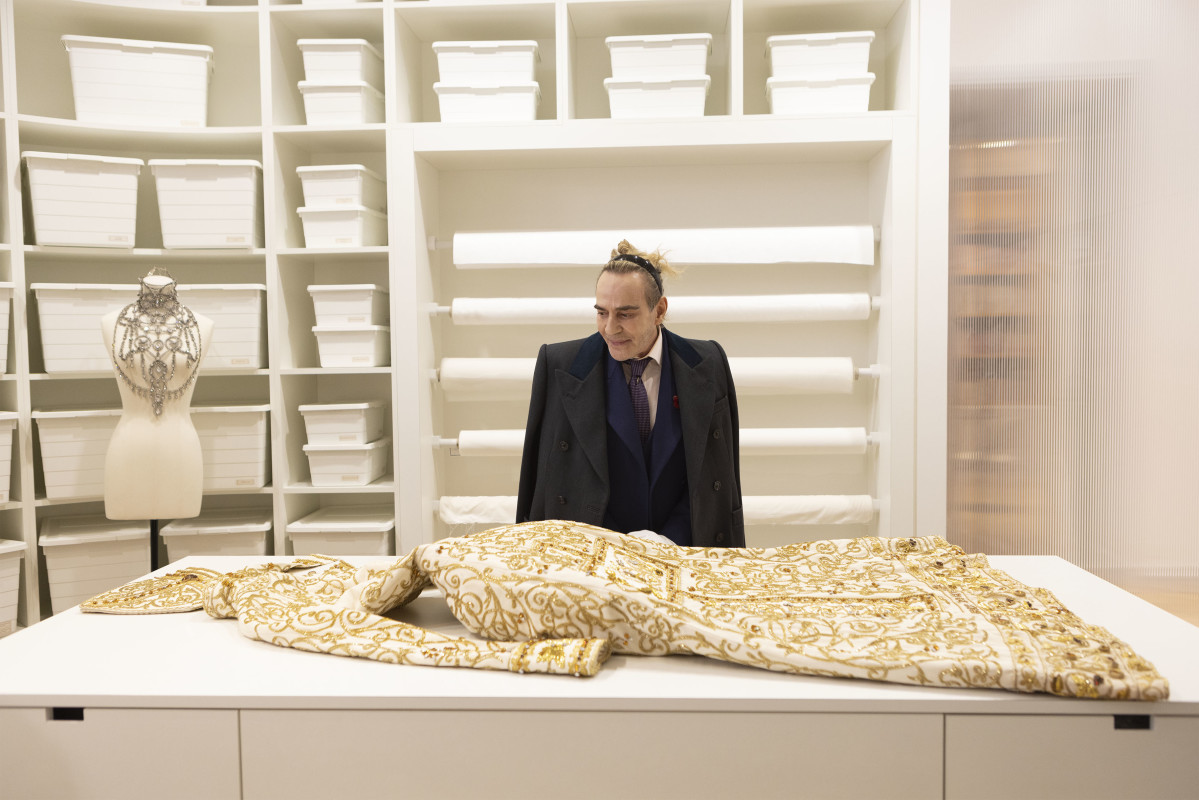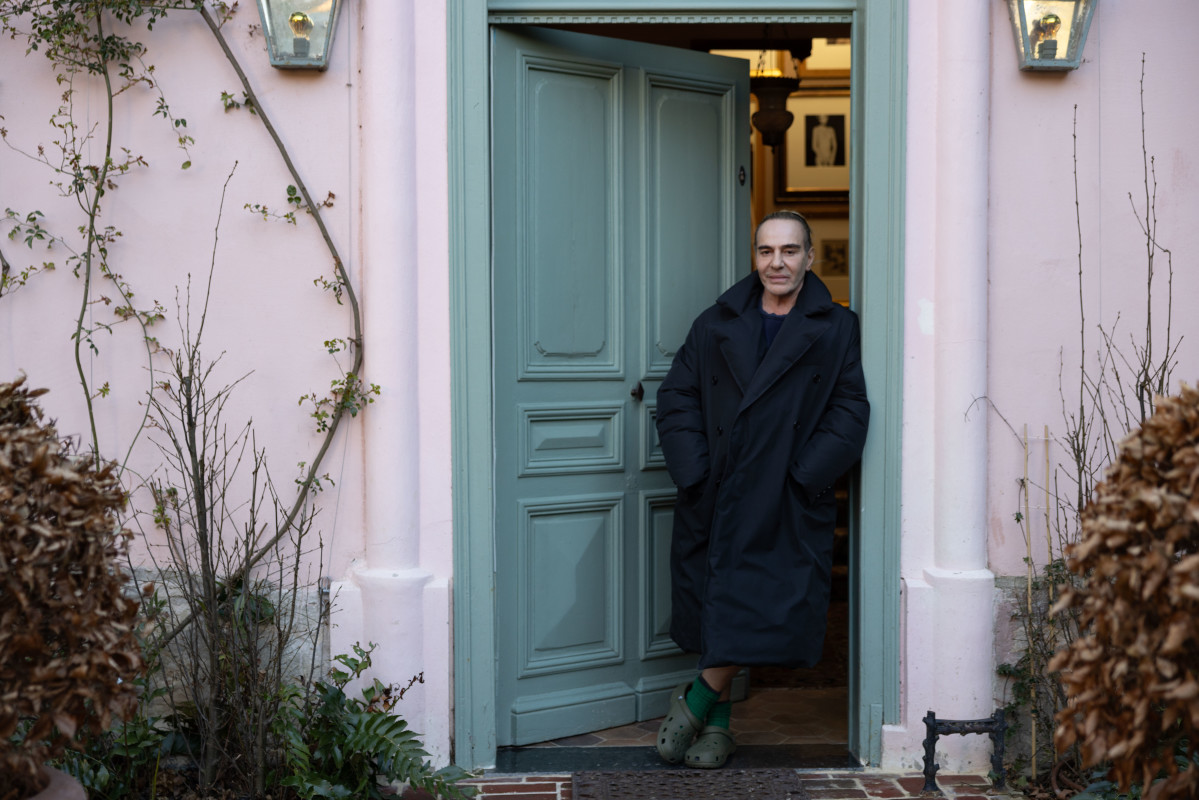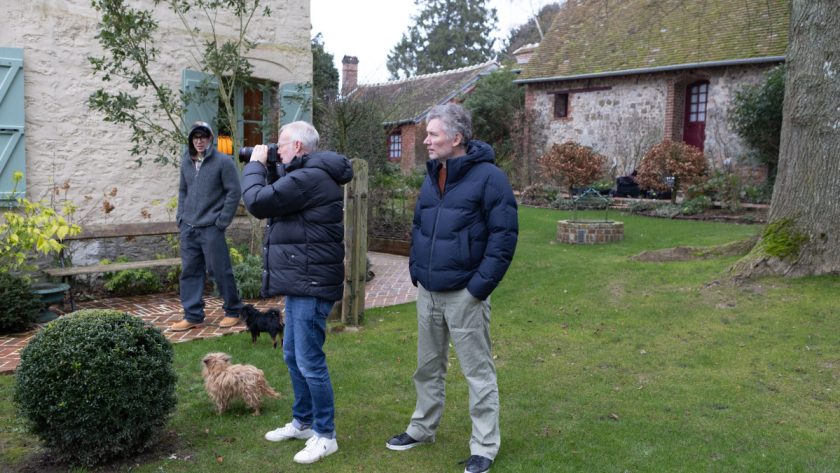In January, John Galliano staged an instantly-memorable Fall 2024 Haute Couture fashion show for Maison Margiela Artisanal that was universally heralded by the industry as a return to form for the British designer, bringing back the energy, theatricality and imaginative storytelling of his Dior runways from the ’90s and ’00s.
He’s been at Margiela for almost a decade, but he’s maintained a low profile, especially compared to his more forward-facing and limelight-loving persona during the LVMH days. Of course, this is a result of what happened in 2010: the series of antisemitic outbursts that were caught on camera, led to his ousting from Dior and resulted in a conviction in French courts.
It wasn’t Galliano’s first instance of bad behavior, but it was, without a doubt, his most serious, painful offense — and the one with the greatest consequences. He expressed regret, went to rehab, got sober and has mostly stayed out of the headlines since. More than a decade later, it does seem like a lot of the fashion industry has either forgiven him or at least decided to look past what he did, but there are plenty of people who haven’t and won’t.
That’s what drew Kevin Macdonald, an Academy Award-winning filmmaker, to Galliano’s story: Despite not knowing much about fashion, he was intrigued by the question of forgiveness after controversy, and that eventually developed into “High and Low,” a documentary about the designer, his life and what’s happened in the “fourth act” of his story. (It premieres on Mubi on March 8.) It follows Galliano’s upbringing, entry into the industry, meteoric rise, epic fall and the aftermath.
“High and Low” unambiguously frames what happened in a critical way, so the designer doesn’t come off scot-free. (There are clips of the incident, as well as accounts from the people he hurt and the people he sought counsel from afterward.) What Macdonald attempts to do is contextualize it within Galliano’s biography and his state of mind at the time, according to the people that were around him, as well as document what’s happened in the time since. It’s more interested in exploring the idea of forgiveness than offering the viewer a definitive answer.
Fashionista spoke with Macdonald about the making of “High and Low,” what he learned during the filming process and what’s surprised him about the reaction to the film. Read on for highlights from the conversation.
Photo: Nicholas Matthews/Courtesy of Mubi
You’ve spoken about how you consider yourself a fashion outsider, but you’re making a film about a very, very well-known story within fashion. What brought you to this project, or how did the project come to you?
In broad terms, I was attracted to the story because it’s a controversy, but an ambiguous controversy, by which I mean: How do we really know whether he should be forgiven, whether he shouldn’t be forgiven, what he really thought when he said this hateful thing? Do we believe that he doesn’t remember it? Should people be able to, after a certain period of time, transcend their sins?
During lockdown, I was reading lot of stuff about people being canceled — endless actors in Hollywood, producers and all sorts of people. It got me to thinking about forgiveness, and somebody suggested to me, ‘If you want to make a film about that, you should talk to Galliano.’
I Zoomed with him a couple of times, and he put me onto Anna Wintour, who’s sort of his guardian angel. I think they were discussing, was I the person that they would let make this film? I think John wanted to make a film and was into the idea, but he was very cautious about (who he) could he trust. We then met up in Paris a couple of times, and we talked about it. There was a lot of us both feeling each other out, which happens on any film. But I think, on this, because it’s so sensitive for so many different reasons, he wanted to make sure that I was somebody who he was on the same wavelength as, or who he respected their opinions.
I had final cut that was independently financed, unlike almost every other celebrity film made these days. This is a totally independent production. Nobody put pressure on me to do anything, to leave anything out or to add anything. John was the one who went to the forefront of that. He saw the film early on — he had the right to see the film — but he never tried to persuade me to, ‘Say this,’ or, ‘You’re misunderstanding that.’ He said, ‘You’re the filmmaker. I’m going to correct a couple of factual errors you’ve got in there. I wouldn’t interfere. I wouldn’t let you to come into my atelier and tell me what length my hem should be, so I’m not going to tell you about the film.’
There was never a PR person. I never met a PR person. He never had anybody there. It was just him and me, and we talked in a very human, one-to-one way.
That’s extremely rare in the fashion industry.
It’s extremely rare anywhere, but particularly in the fashion industry. I think it’s a testament to the seriousness with which John took it.
How long was that process, of convincing him to participate?
I did the first filming in the summer of 2022, and I spoke to him first about a year before that. So, about a year, maybe 14 months. I wasn’t 100% sure whether he could hold a film, because, obviously, this is an interesting story, but can this person be the center of film and be interesting and compelling to an audience?
So, I got some development money, and I shot an interview with him for a day and a half in the south of France, when he was on holiday. And I was convinced, by that interview, that he was really interesting and would make a great subject. That was when we said, ‘Okay, let’s definitely make the film.’ That makes up about half of the interviews in the film, actually.
As you were familiarizing yourself with John Galliano and his work, what was your impression or understanding of him? How did that evolve over the course of you then meeting and interviewing him?
Well, I had quite a dismissive, I suppose you would say, view of fashion before. I wasn’t that interested… I thought it was kind superficial, all the clichés you would imagine from a middle-aged straight man. One of the things that transformed throughout my time working with him and making the film was an ever-growing appreciation of fashion in general, but particularly of him and an understanding that he’s a real artist… I did strive to get inside that world and understand: Why do people think he’s so great? It took me a long time to figure out.
There’s been a lot of debate around the content of the film — people like him, don’t like him, want to argue — and all those things, which are great. I like that. But also, I think everybody who’s come out who I know has said the same thing: ‘Oh, he’s a genius, isn’t he?’ I’m really pleased with that, that people come out and they maybe don’t like him, but they say, ‘Well, he’s a genius.’ I think I’ve shown and explained a bit about why he’s so revered in the industry.
Was that the conclusion you came to over the course of filming?
I came to really greatly appreciate his work and to understand that it was deeply personal in a way that I didn’t comprehend to begin with, that it’s an expression of his psychological state… In a way, you can trace, as you would making a film about Cézanne or someone, their life story and their psychological journey through their work. I think you can see that — or, at least, when you know the basics of the biography and of the psychology, you can infer a lot. That makes it really interesting. It’s a bit like with McQueen. To me, that probably is what qualifies you as an artist, isn’t it?
Photo: David Harriman/Courtesy of Mubi
The documentary goes through his biographical timeline, but you also frame it in the context of two films, Abel Gance’s 1927 “Napoleon” and Michael Powell and Emeric Pressburger’s “The Red Shoes.” In an interview with Galliano, you directly compare him to Napoleon, and he refutes that. But I’m curious what parallels you drew there as you were telling the story, and why you think he disagreed with them.
I did a Q&A the other day in Dublin with the film, and a woman said to me, ‘Why did you keep sharing those Napoleon clips? Galliano said it had nothing to do with him. That’s really disrespectful, isn’t it?’ I think, if you look through the film, you can see him dressed as Napoleon, wearing a Napoleon T-shirt with a Napoleon sketch in the background in 20 different shots. There’s clearly something going on in his mind, whether he acknowledges it or not. But also, there’s a playfulness about it, this parallel of two small southern men who have strong accents, who arrive in the big city, who are rejected, who are bullied and who rise to the top of Paris and who then both meet their Waterloo. It gives the film a flavor and a humor that maybe it would’ve been lacking otherwise.
When John saw the film, he came out crying. He was quite upset. I thought there were lots of things where he was going to go, ‘Oh my God, don’t say that.’ I said to him, ‘This is still a rough cut, and we may have to lose the Napoleon clips because we can’t clear the rights.’ He was like, ‘What? That would be a disaster. I love the Napoleon clips. What can I do? Can I speak to somebody? What can we do to get the Napoleon clips?’
There’s a playfulness to that, when he’s arguing with me. But I’m also saying that, sometimes, maybe he doesn’t know himself.
You mentioned how, when you first approached Galliano, you were looped in with Anna Wintour, and thus Vogue and Condé Nast. How did you go about casting the rest of the film and the people you wanted to speak to this?
You’ll notice on the film that Condé Nast have an associate producer credit and a coproducer credit. That’s because I realized, at a certain point, that I needed help getting into the fashion world, and that actually it was very hard for me to turn up to Dior and say, ‘Can I speak to you about the worst incident in your recent history?’ Condé Nast was able to make those introductions and help, and that was really incredibly useful. But I would reiterate that the work is my work, and entirely my take on it. I don’t think necessarily that they would agree with everything that’s in the film, but they were incredibly useful.
Anna Wintour has this very special connection with Galliano. I think she feels a bit protective towards him, and feels that he’s this great genius — that even though it might cost her something, she wants to support him. Why that is, exactly, I don’t know. But I don’t think there’s anything sinister to it… Really she’s only risking something to her own reputation. She’s got nothing to gain from her support for him. That goes, by the way, for a lot of the other people in the film, a lot of the other celebrities who are taking a bit of a risk by doing the film, but wanted to because they wanted to support John.
The support of John, even when problems arose before the anti-semitic incidents, is something that’s explored throughout the film. You see kind of the trouble brewing, and people still wanting to show up for him and even after. How did you approach telling the story of the aftermath, that has become very gray?
Editing the film was really hard. It’s a four-act story, and you’re always told that every film has to be three acts. But this is a four-act story because he should have died… But, oh, he wakes up, he’s still alive and he’s got to excuse himself and find a way to make his life right again. That, to me, is the most interesting part. It’s the most unique part.
That’s where a lot of people have different opinions — a lot of people who found it hard to and did eventually forgive him, in the case of (former Dior CEO) Sidney Toledano; (people who) didn’t, in the case of the victim, Philippe Virgitti, who has changed his mind about him. Yet, there are these people, like Naomi (Campbell) and Kate (Moss), who insist on seeing and supporting their friend, the person they want to be loyal to. And I admire that.
What Naomi says is very forceful. She shuts down any conversation about the video — ‘I didn’t see the video. It’s not who he is. It’s not my friend.’ Some people will take that and go, ‘Oh, that’s so insensitive.’ But she’s not saying that what he did wasn’t reprehensible. She’s just saying, ‘He’s also my friend, and I’m going to support him as my friend.’
At what point in your conversations with John did you discuss the antisemitic remarks?
Obviously, I raised it with him before we shot the film, and he made it clear that nothing was off-limits. It was important to me to hear that. We didn’t talk about it in the first interview. I don’t like to talk to the person much in advance about what I’m going to say to them — I try and talk about frivolous things or about other things than what we’re going to really talk about in the film. I want that conversation to be fresh, because the first time you say something’s very different than when you’re saying it for the second, third time to somebody. The performance is different.
He has a lot to say about it. And the conversation often returns to it, in various different ways… He never tried to shut me down on it or on discussing things adjacent to it. The only time he didn’t want to continue talking was, actually, early on, we talked about his father and the homophobic violence and abuse he’d received. He found that very difficult to talk about. I didn’t necessarily want to go into that in great detail anyway because I didn’t want people to feel like, ‘Oh, you’re excusing his behavior by telling us he had a terrible childhood.’ I wanted to show he had this terrible childhood that influenced who he became as a designer, but I’m not sure it has any bearing on what happened later.
It goes back to your original conceit for this project, which was about exploring cancel culture. The film doesn’t make a judgment — it doesn’t say whether he’s forgiven or whether he’s made amends.
You start off doing this in a very abstract way — ‘Oh, wouldn’t it be interesting to look at that theme?’ But then it quickly becomes about a person. In a way, I don’t think the film is about cancel culture. I think it’s a character study of this really fascinating, ambiguous man.
Photo: Courtesy of Mubi
In the time since you’ve put down the cameras and seen how some of the industry has embraced Galliano, how have you been working out those ideas of what happens in this fourth act?
There was a thing that the rabbi said to me that isn’t in the film: ‘What’s the point of religion if you don’t believe people can change?’ And I thought that was so wise. Well, yeah, we’ve got to believe that people can change. We’re going to believe that somebody does something bad, and then they’re like that for their whole lives and can’t educate themselves? That’s a very pessimistic view of humanity.
If you’re offended by him and can’t ever forgive him, I’m not telling you that you’re wrong. I’m saying that, personally, I think society should be able to do that and move on. The people who he really hurt have forgiven him, except for Philippe, who hasn’t. Who am I to say that he shouldn’t be? I also think, what else is he going to do? We want him to go and garden for the rest of his life? He’s great at what he does. He has tried really hard to reform himself, not just in terms of this incident, but in terms of his reputation before, in the way he treated people. He’s totally clean and sober. I don’t think that’s unreasonable, that fashion has moved on and embraced him again.
The film first premiered months ago. In the time since you’ve screened it, has there been anything that has surprised you about the reaction?
There’s a lot of debate, which I really wanted. I wanted to make a film that’s honest about how complex and gray it is, and therefore how you can interpret it in different ways depending on your personality, your convictions, whatever.
Obviously, the bigger political environment has meant that there’s much more focus on antisemitism in the wider culture than there was when I finished the film or even when I started the film. I alternate between feeling that makes the timing for this film bad or good. Isn’t it quite good for us to be exploring antisemitism — where does it come from, why is that the thing he chose to say, what are the drivers of that hatred, why is it deep down in some people? It’s never a bad time, I think, to talk about the education of people, of people who have bigoted beliefs.
You’ve said how a lot of your work has centered around complicated figures and difficult subjects, and, still, within this, the fashion industry was new to you. Given your experience and your work so far, was there anything that really surprised you that you learned about this business?
I was surprised by everything. I went in having seen ‘The Devil Wears Prada,’ and that was my primary knowledge. I was surprised by how pleasant, generous and sweet most people I encountered were.
To get more specific, I was utterly shocked to hear how much John’s show that we filmed cost — millions. Still, to this day, I don’t understand why they only have 250 people come and see it, and they put it on once. What’s this about? No other industry does this. I was told, ‘It’s all about exclusivity.’ And I’m thinking, ‘Yeah, but you could still be exclusive. You could have had a thousand people there.’ It was a huge theater, and they just had the first four rows or something. That’s a peculiar thing.
“High and Low” is available on Mubi starting on March 8.
This interview has been edited and condensed for clarity.
Never miss the latest fashion industry news. Sign up for the Fashionista daily newsletter.



